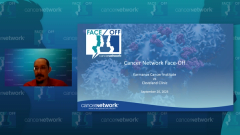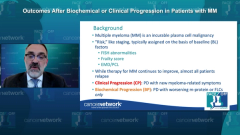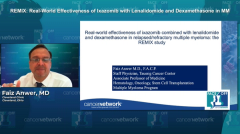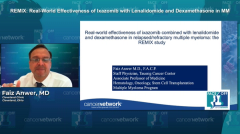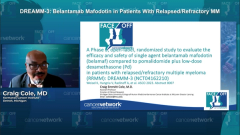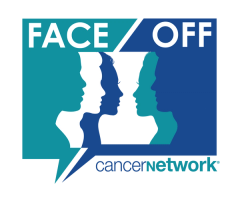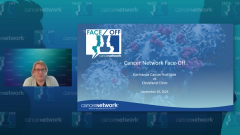
Cross Q&A: Efficacy of CAR T-Cell Therapy in MM
The expert panel discusses the efficacy and durability of response of ciltacabtagene autoleucel in patients with multiple myeloma.
Episodes in this series

Transcript:
Andrew Kin, MD: There’s a big drop-off in the beginning, that very first month, while patients were waiting on their CAR [chimeric antigen receptor] T cells to manufacture. I think it’s 1 in 6 patients from their CONSORT diagram had disease progression even before receiving therapy. Did they say what their bridging was? Did they allow bridging?
Jack Khouri, MD: They did allow bridging, and it was basically the same treatment that was given to the standard-of-care arm, so either PVd [pomalidomide, bortezomib, dexamethasone] or DPd [daratumumab, pomalidomide, dexamethasone].
Moaath Mustafa Ali, MD, MPH: This was the intention-to-treat analysis? If all patients from the time they enrolled had any progression at the beginning, they were not dropped from the analysis, correct?
Jack Khouri, MD: Correct, [it was] intention-to-treat analysis.
Craig Cole, MD: Was it the minority of patients who ended up getting bridging therapy? Because I thought it ended up having a low number.
Jack Khouri, MD: It was a low number. I can’t remember off the top of my head. But I agree; it was a low number.
Craig Cole, MD: [That] makes me think, and I’m assuming that the manufacturing time was quite a while. In the standard-of-care arm, you can just ignite that on day 1, [whereas] the patients on cilta-cel [ciltacabtagene autoleucel]had to wait, which could lend itself to a better disease biology for the cilta-cel arm than the standard-of-care arm.
Moaath Mustafa Ali, MD, MPH: I’ve noticed in all or almost all CAR T-cell treatments [that] there’s no plateau in progression-free survival [PFS], and that tells you that CAR T-cell [therapy] is not curative. We have had long follow-up durations, especially for lymphomas and even certain multiple myeloma [MM] products. We don’t see any plateau, so it’s not curative. And in patients, it is an option but not necessarily the last option that will cure the patient.
Jeffrey Zonder, MD: But it is a head-to-head victory over approved triplets in this same space, right? So it may not be curative [like] other therapies [that] aren’t, but it still represents an emerging superior option compared with some regimens that we’re already using.
Charles Schiffer, MD: I’ve got a question and a comment. I don’t know how many CAR [T-cell] products for myeloma there are available at the moment, but whatever the number is, it’s going to be more. And they were all originally approved on [findings from] phase 2 trials. There are going to be newer [and] fancier ones, antigens other than BCMA [B-cell maturation antigen], if you follow the lymphoma paradigm, dual targeted, etc.
And how do you develop these drugs in a regulatory fashion? When do you have to randomize trials comparing it with another CAR [T-cell therapy]? You don’t have to compare it with chemotherapy anymore; that question’s been solved. But which CAR [T-cell therapy] do you choose? How can you do those trials in a practical sense? And how do you choose as a clinician among the ones that are already available?
Jack Khouri, MD: These are good questions. Do we have an answer to them, though?
Faiz Anwer, MD: I have a comment. I don’t have an answer. I think at this time
we may not be interested in doing a head-to-head study because the speed and the number of therapies being developed in this space is so fast. On one hand, we have patients who are on their 17th, 18th, or 19th line of therapy and are always in need of the next line of therapy. We are always in need of the next phase 1 or phase 2 study in the immunotherapy space. I think we have emerging data with the LEGEND study [NCT02608515]; we now have 5-year follow-up data. I think if we compare ide-cel [idecabtagene vicleucel] with cilta-cel, we know which product has the longest PFS available at this time. Of course, there are unique differences in the toxicity and cytokine release syndrome.
Charles Schiffer, MD: I was asking a regulatory question, not from the perspective of the clinician. I own this company, I have this product, or I’m thinking of investing in it. What’s it going to take? What’s it going to cost to get it approved? The first couple of CAR T-cell [therapies] were relatively easy. They had impressive responses, and you could get away with a phase 2 study approval. Now there’s a standard of care. How do you get your putatively new and improved treatment approved?
John Molina, MD, MEd: Most of my experience has been in the CAR [T-cell therapy] for B-ALL [B-cell acute lymphoblastic leukemia], and that’s a challenge in that space where things have slowed down. You have to be exposed to these as the standard of care, which leads to antigen modulation and self-selecting other populations. So future CAR [T-cell therapies] are going to have novel targets. I think that’s the problem…. We’ll have frontline therapy that you choose as the best option, and what’s going to be down the road is either novel bicistronic [or] bivalent [therapies] targeting multiple things at the same time. That’s the inherent challenge in the CAR [T-cell] space, and further development…slows down because you’re stuck. And then you’re stuck in the ramifications of what that treatment does in terms of the patient population you select. I think that’s why we see in some of these earlier phases where they’re going to CAR [T-cell therapy] sooner, it does significantly better because they haven’t been as exposed to as many lines of therapy, leading to intrinsic T-cell deficits and the ability to create a better product.
Jack, one of the things that doesn’t come up here and comes up in the leukemia space is tumor burden and blast percentage in terms of efficacy of these CAR [T-cell therapies]. Do they report that in terms of differences between the 2 groups? Because that’s become a significant difference, to go back to Moaath’s response. We’re trying to learn. It seems certain populations are potentially curative, but it’s going to be very specific groups with very low disease burden that may have better long-term outcomes. I don’t know this space with this CAR [T-cell therapy]. Did that come up in the trial?
Jack Khouri, MD: So everybody responded in this study. There was no major difference in response rates, but something that’s emerging is that we’re seeing more of these delayed neurotoxicities in people with a lot of disease burden going into it. So there is now this mitigation strategy where you have to try to cytoreduce patients as much as you can before you infuse them…to try to prevent these Parkinson [disease]– like cognitive effects and movement disorders that could happen.
So it’s more from a safety perspective and making sure that people don’t have these delayed neurotoxicities. But people with plasmacytomas, people with more than 60% plasma cell burn, responded very well in this study.
John Molina, MD, MEd: I think this question is response or durability, because they respond in B-ALL. The problem is that they’re not durable. When you risk stratify less than 5% or greater than 5% blast, that’s how you get people who have long durable survival vs less than 5% blast or greater, which is a small number.
So everyone will get it. That’s the beauty with CAR [T-cell therapy]. You get day 28 complete responses, that MRD [minimal residual disease]-negative [result]. The question is, where does it go? And I think that comes in the mitigation strategies. Who needs additional consolidated or maintenance therapy?
Jack Khouri, MD: And we did see [findings from] studies with more long-term follow-up where patients whom you’re talking about, people with more disease burden, did not respond for long. So there were patients who [experienced relapse] quicker. For this one, we’re going to need more long-term follow-up to see that. We haven’t seen it. But I think we will see it in people with more disease burden.
John Molina, MD, MEd: Back to the regulatory question…that’s going to be the sites in which we try to identify new CAR [T-cell therapies]. So it’s less toxicity burden on subpopulations, which makes the CAR [T-cell therapy] space incredibly challenging. And in the AML [acute myeloid leukemia] space, you can’t use a generic target; everything is going to be boutique CAR [T-cell therapies]. A company coming into [this] space and what you’re going to create and where are going to be limited based on the populations that have come out. And it’s going to be more and more specialized CAR [T-cell therapies] potentially in the future.
Transcript is AI-generated and edited for clarity and readability.
Newsletter
Stay up to date on recent advances in the multidisciplinary approach to cancer.


